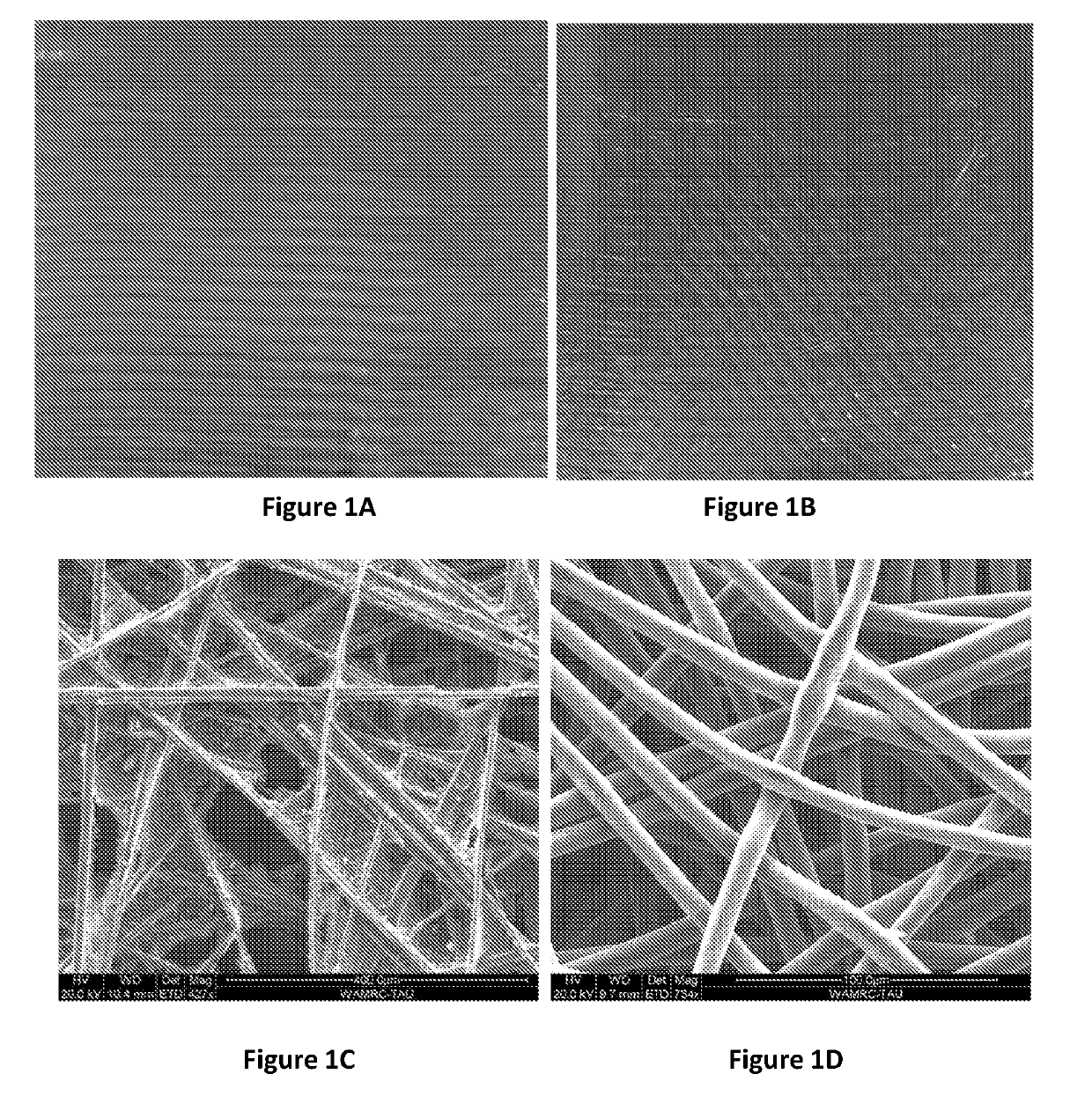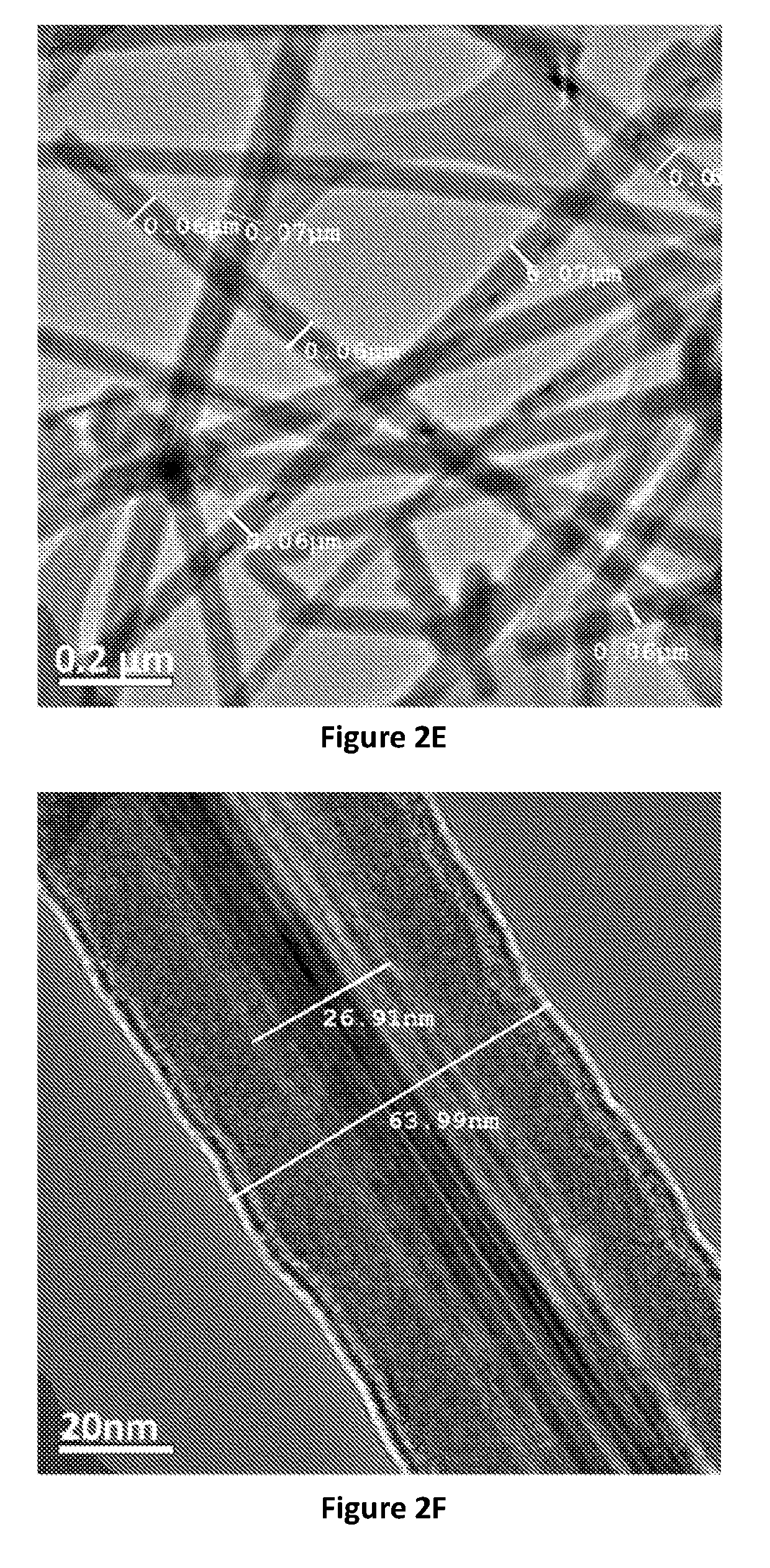High-capacity silicon nanowire based anode for lithium-ion batteries
a lithium-ion battery, high-capacity technology, applied in the direction of electrode manufacturing process, vapour deposition manufacturing, nanotechnology, etc., can solve the problems of large volume expansion and contraction, cracking and pulverizing of anode material, inducing a rapid degradation of si-based anodes, etc., to achieve high loading, high capacity, and current efficiency greater than 99.5
- Summary
- Abstract
- Description
- Claims
- Application Information
AI Technical Summary
Benefits of technology
Problems solved by technology
Method used
Image
Examples
example 1
Battery Fabrication
[0229]SiNWs Growth on the Carbon-Based Substrate:
[0230]
TABLE 1SiNWs anodes having various loadings and different substrates.Si loadingcells builtsubstrate(mg / cm2)SiNWs modificationof samplescell nameFreudenberg1.082FRD1, FRD2SGL1.0562SGL1, SGL2Freudenberg0.112FRDN1, FRDN2SGL0.462SGLN1, SGLN2Freudenberg0.242FRDS1, FRDS2SGL0.172SGLS1, SGLS2SGL0.23——SGL0.36——Freudenberg0.593FRDS3, FRDS4,FRDS5Freudenberg0.62——SGL1.63——SGL0.953SGLS3, SGLS4,SGLS5SGL1.923SGLS6, SGLS7,SGLS8Freudenberg3.46——SGL5.16——Freudenberg7.882FRDS6, FRDS7SGL4.72SGLS9, SGLS10Freudenberg2.63——SGL2.87——Freudenberg1.881 vs. Li,FRDS8, FRDF11 vs. LFPSGL1.551 vs. Li,SGLS11, SGLF11 vs. LFPFreudenberg0.96—SGL0.94—Freudenberg0.48—SGL2.30—Freudenberg2.28—Freudenberg1.98Boron doping 1:80002FRDS11, FRDS12Freudenberg1.88Boron doping 1:10002FRDS13, FRDS14Freudenberg1.39Boron doping 1:8000,1FRDC3carbon coatingFreudenberg1.39Boron doping 1:8000,1FRDC4carbon coatingFreudenberg1.75Boron doping 1:1000,1FRDC5carbon coati...
example 2
y Characterization of the Anodes
[0251]The morphology of the samples was examined by using several techniques, including Scanning Electron Microscopy (SEM) on Quanta 200FEG ESEM equipped with an energy dispersive X-ray spectrometer), Transmission Electron Microscopy (TEM) on FEG-HRTEM, Fei Tecnai F20, X-ray diffraction (XRD) on Bruker, D8 Discovery, Transmission Electron Microscopy (TEM) and Environmental Scanning Electron Microscopy (ESEM).
[0252]FIGS. 2A-2C show SEM micrographs of the one of the surfaces of the anodes, including SiNWs chemically grown on the fibrous carbon substrate (FIG. 1C), manufactured according to the procedure described in Example 1, having various Si loadings (0.36, 1.92 and 4.7 mgSi / cm2, respectively), while FIG. 2D represents a SEM micrograph of the 4.7 mgSi / cm2 anode cross-section. It can be seen that SiNWs are present both on the surface of the anode and in the bulk portion thereof, thus significantly increasing Si loading and geometric capacity of the an...
example 3
n and De-Lithiation Capacity and Faradaic Efficiency of the Anodes
[0259]Several SiNW-SGL anodes, with Si loadings in the range of 0.36 to 4.7 mgSi / cm2 were tested in SiNW / Li coin cells. The cells were tested at 30° C., with the use of an Arbin BT-2000 battery tester. For aging tests, the cells were cycled at a constant current of 1 mA, in the range of 0.01-1V. At the beginning of the tests, and after 100 and / or 200 cycles, the cells were cycled for a few cycles at 0.1 mA (FIG. 6A). This was done in order to determine the maximum (full) capacity of the SiNWs-based anode. The anodes contain both carbon (in the SGL paper) and SiNW. In order to calculate the specific capacity of each component, parallel cycle life tests of only the SGL paper were run. FIG. 6B depicts both the SiNWs-based anode capacity, and the SGL electrode capacity versus the cycle number and FIG. 6C shows the SiNWs-based anode capacity. For anodes having 1.06 mgSi / cm2 loading, at high current density of 1 mA / cm2, the...
PUM
| Property | Measurement | Unit |
|---|---|---|
| length | aaaaa | aaaaa |
| length | aaaaa | aaaaa |
| length | aaaaa | aaaaa |
Abstract
Description
Claims
Application Information
 Login to View More
Login to View More - R&D
- Intellectual Property
- Life Sciences
- Materials
- Tech Scout
- Unparalleled Data Quality
- Higher Quality Content
- 60% Fewer Hallucinations
Browse by: Latest US Patents, China's latest patents, Technical Efficacy Thesaurus, Application Domain, Technology Topic, Popular Technical Reports.
© 2025 PatSnap. All rights reserved.Legal|Privacy policy|Modern Slavery Act Transparency Statement|Sitemap|About US| Contact US: help@patsnap.com



